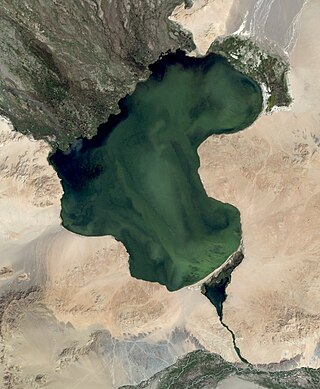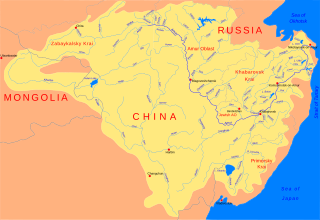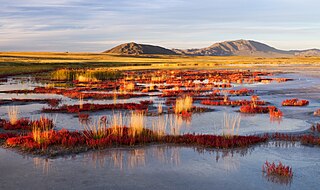
A transboundary protected area (TBPA) is an ecological protected area that spans boundaries of more than one country or sub-national entity. Such areas are also known as transfrontier conservation areas (TFCAs) or peace parks.

The Bayankhongor Province or Bayanhongor Aimag is one of the 21 aimags (provinces) of Mongolia. It is located in the southwest of the country and, at 116,000 square kilometers, it is one of the largest aimags. The capital of the aimag shares the provincial name, Bayankhongor.

Hulunbuir or Hulun Buir is a prefecture-level city in northeastern Inner Mongolia, China. Its administrative center is located at Hailar District, its largest urban area. Major scenic features are the high steppes of the Hulun Buir grasslands, the Hulun and Buir lakes, and the Khingan range. Hulun Buir borders Russia to the north and west, Mongolia to the south and west, Heilongjiang province to the east and Hinggan League to the direct south. Hulunbuir is a linguistically diverse area: next to Mandarin Chinese, Mongolian dialects such as Khorchin and Buryat, the Mongolic language Daur, and some Tungusic languages, including Oroqen and Solon, are spoken there.

Uvs Lake is a highly saline lake in an endorheic basin—Uvs Nuur Basin, primarily in Mongolia with a smaller part in Russia. It is the largest lake in Mongolia by surface area, covering 3,350 km2 at 759 m above sea level. The northeastern tip of the lake is situated in the Tuva Republic of the Russian Federation. The largest settlement near the lake is Ulaangom. This shallow and very saline body of water is a remainder of a huge saline sea which covered a much larger area several thousand years ago.

Ebi Lake is a rift lake in Xinjiang Uyghur Autonomous Region in Northwestern China, near the border of Kazakhstan. Lying at the southeast end of the Dzungarian Gate, Ebi Lake is the center of the catchment of the southwestern part of the Dzungarian Basin. The lake previously covered 1200 km2, which is now down to under 1000 km2 with an average depth of less than 2 meters. In August 2007, the Chinese government designated the adjoining Aibi Lake wetland as a National Nature Reserve.

Hulun Lake or Dalai Lake is a large lake in the Inner Mongolia region of northern China.

Achit Lake is the largest freshwater lake in Uvs Aimag, Mongolia, in the west of the country. At an elevation of 1,435 m above sea level it covers an area of 290 km2. It is 28 km long, 16 km wide, and 10 m deep. The coast is covered with steppes, mostly hilly but swampy on the northwest and northeast. Several rivers flow into the lake.
Terkhiin Tsagaan Lake (Mongolian: Тэрхийн Цагаан нуур, romanized: Terkhiin Tsagaan nuur,, is a fresh-water lake in the Khangai Mountains in central Mongolia, located in Tariat soum of Arkhangai province. In 670 km to the capital city Ulaanbaatar and 180 km to the center of Tariat soum.

The Khalkh River is a river in eastern Mongolia and northern China's Inner Mongolia region. The river is also referred to with the Mongolian genitive suffix -iin as the Khalkhin Gol, or River of Khalkh.

The Mongolian-Manchurian grassland, also known as the Mongolian-Manchurian steppe or Gobi-Manchurian steppe, in the temperate grassland biome, is an ecoregion in East Asia covering parts of Mongolia, the Chinese Autonomous region of Inner Mongolia, and Northeast China.
China Biosphere Reserve Network (CBRN) is a network established by the Chinese National Committee for UNESCO Man and the Biosphere Programme in 1993. Membership in the CBRN serves as a prerequisite for joining the World Network of Biosphere Reserves (WNBR). At present there are 200 members in the CBRN, including 34 UNESCO Biosphere Reserves.

Uvs Lake Basin is an endorheic basin located on the territorial border of Mongolia and Tuva, a republic of the Russian Federation. The basin is part of the Central Asian Internal Drainage Basin and is named after Uvs Lake, a large saline lake situated in the western part of its drainage basin, and is one of the last remnants of the mammoth steppes. Uvs Lake is a shallow lake with an area of 3,350 km2 (1,290 sq mi). Its entire basin, which includes several smaller lakes, is 70,000 km2 (27,000 sq mi).
Hay-Zama Lakes is a 586-square-kilometre (226 sq mi) inland wetland and wildland park in northwestern Alberta, Canada. It was designated a Ramsar wetland of international importance on May 24, 1982, and is recognized as an Important Bird Area. It "constitutes one of the most extensive sedge wetlands in western North America".

Buir Lake is a freshwater lake that straddles the border between Mongolia and China. It lies within the Buir Lake Depression. The Chinese city of Hulunbuir is named after both this lake and Hulun Lake, which lies entirely on the Chinese side of the border in Inner Mongolia.

The wildlife of Mongolia consists of flora, fauna and funga found in the harsh habitats dictated by the diverse climatic conditions found throughout the country. In the north, there are salty marshes and fresh-water sources. The centre has desert steppes. In the south, there are semi deserts as well as the hot Gobi desert in the south, the fifth-largest desert in the world.
The Hanma Biosphere Reserve is located in Inner Mongolia and encompasses a significant part of the boreal forest (Taiga) found in China. The reserve covers a range of forest and wetland ecosystems rich in biological diversity, including many types of endangered and rare species. Ecological interference by humans is minimal, resulting in abundant natural resources and the high quality of local vegetation and ecology. The cold temperate coniferous forest represents the most well-preserved forest system in China and is of significant scientific value.

Taatsiin Tsagaan Lake is a large saline lake in Övörkhangai Province in the Gobi Desert of southern Mongolia.

Har Us Nuur National Park is a national park in Khovd Province, Mongolia. It covers a chain of three large lakes in the Great Lakes Basin of western Mongolia. The lakes, Khar-Us Nuur, Khar Lake and Dörgön Lake are bordered by marshes and reed-beds that are an important breeding sport for birds, over 200 species of which have been identified in the park. Mount Jargalant is on the southern shore of Khar-Us. This park is distinct from Khyargas Nuur National Park, another large lake in the region, but 60 km to the north.

The Torey Lakes are a pair of soda lakes, Barun-Torey and Zun-Torey, in Russia's Zabaykalsky Krai, on the border with Mongolia — the Mongolia–Russia border runs across the southern tip of Zun-Torey lake.















